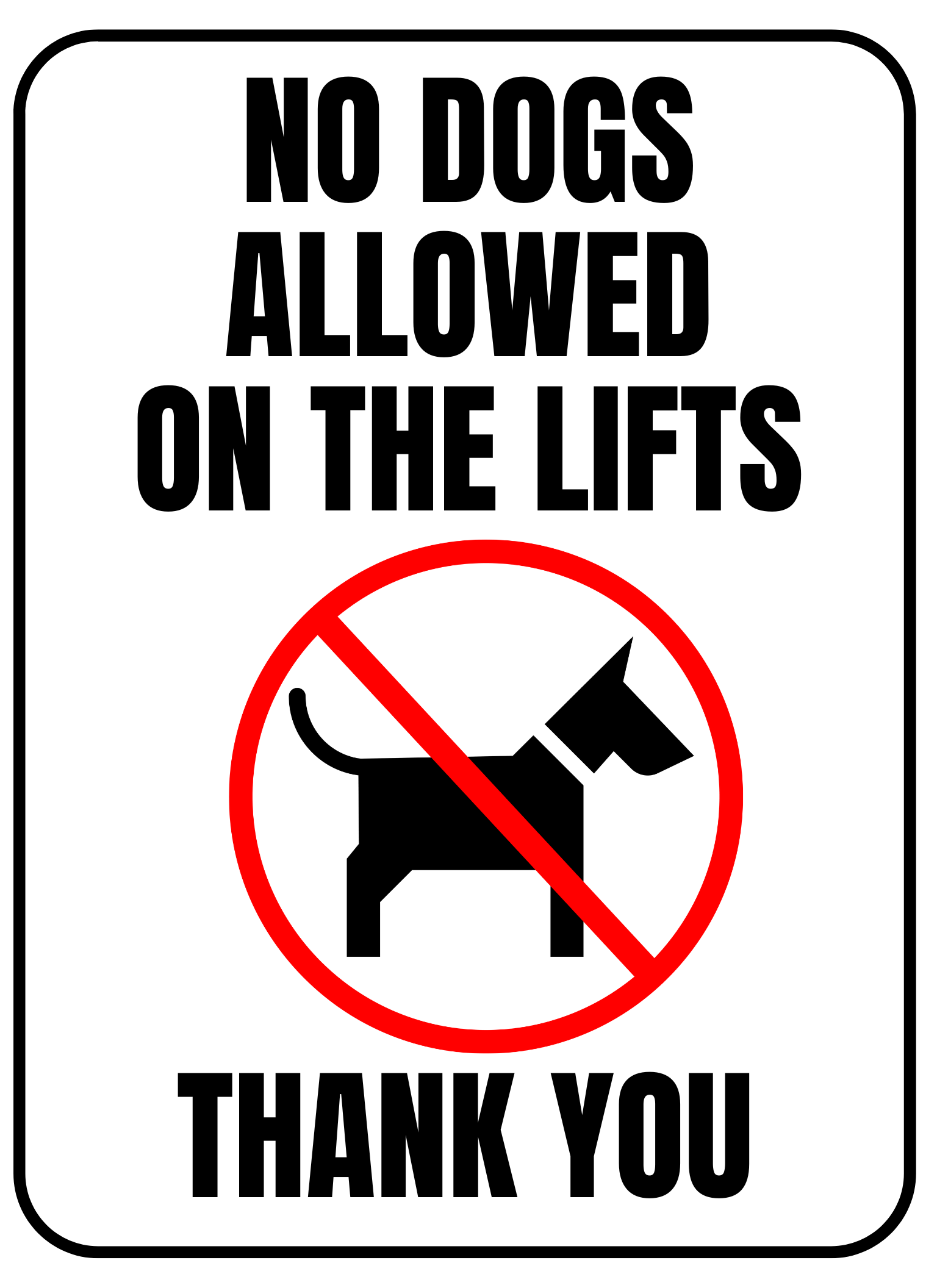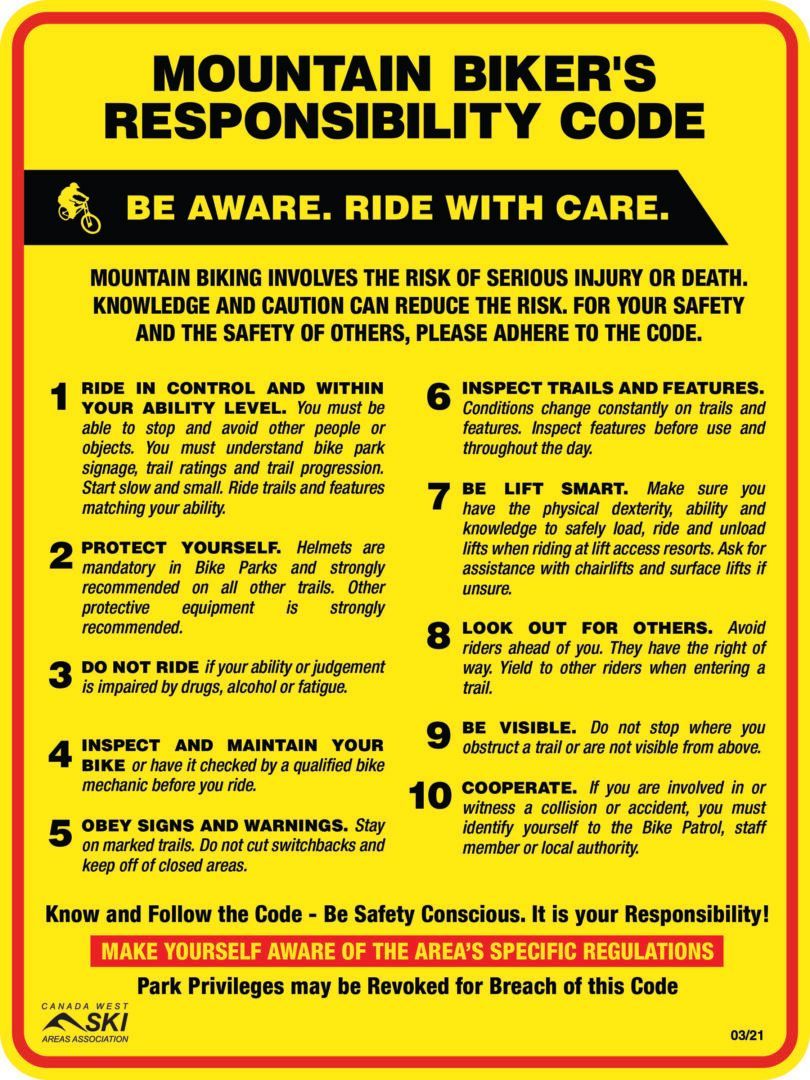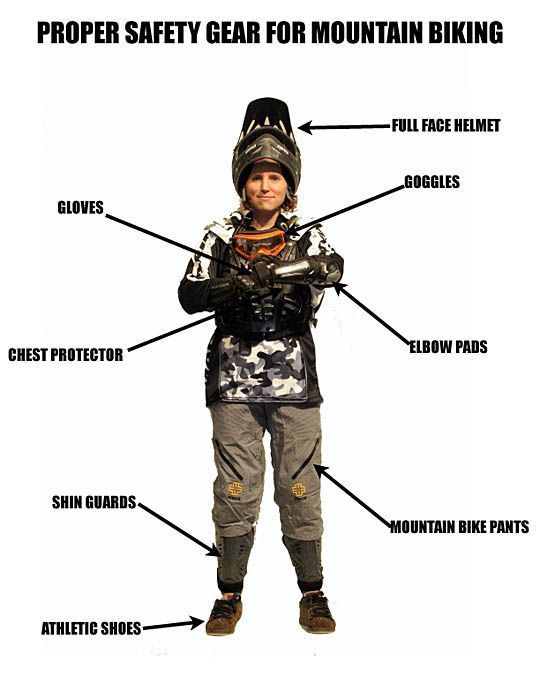
BIKE PARK RULES & REGULATIONS
TRAIL USE
- Hiking and Trail Running will be allowed on the designated Uphill Trail being built Spring of 2024
- Hikers and Runners (with a valid Season Pass or Day Ticket) can hike/run up and down the Uphill Trail
- Mountain Bikers can bike up the Uphill Trail, but not down - that's what the downhill bike trails are for!
- The Chairlift is for mountain bikers and bikes only
- The minimum age to mountain bike in the Bike Park is 6. Please note, we do not allow the use of 'Shotgun' or frame-mounted seats for kids in the Park
- E-bikes must stay on the Uphill Trail if pedalling uphill – riding up ski runs is not permitted
- Class 1 E-bikes only (pedal assist, no throttle)
Waivers must be signed for all participants before biking on Poley Mountain
- Ages 6-11 must be accompanied by a parent or guardian
- Ages 12-17 must have a signed waiver by their parent or guardian
- Ages 18+ must be prepared to sign a waiver
Bike Protection
| Helmet | Helmets are required for all riders in the bike park - both uphill and downhill. A full helmet is recommended. |
|---|---|
| Gloves | Full finger gloves will protect you from blisters and abrasions. |
| Knee and Elbow Pads | Essential piece of mountain bike protection. |
| Shoes | Sturdy soled closed-toe shoes are essential for protection and support. |
| Eye Protect-ion | Goggles or sunglasses will protect against dirt, dust and branches. |
| Long Sleeve Shirt | Long sleeves provide protection against scratches and sun exposure. |
| Water | Whether it is in your back pack, hip pack or in a holder, water will keep you hydrated and keep you going on the trails. |
Mountain Bikers Responsibility Code
Mountain biking involves elements of risk that common sense and personal awareness can help reduce. Please adhere to the responsibility code, and share a safe experience with others.
- Ride in control and within your ability level. You must be able to avoid other people or objects.
- Stay off the lifts and trails if your ability is impaired by drugs, alcohol, or fatigue.
- All riders must wear a helmet and gloves. Other protective equipment is strongly recommended.
- Inspect your bike or have it checked by a qualified bike mechanic before you ride.
- Be sure to have the physical dexterity, ability, and knowledge to safely load, ride, and unload lifts. Ask the lift attendant for assistance if you need it.
- Be aware of changing conditions on trails and features. Inspect features before use and throughout the day.
- Stay on marked trails. Obey all signs and warnings. Do not cut switchbacks. Keep off closed areas.
- Avoid riders ahead of you. They have the right of way.
- Look uphill and yield to other riders when entering a trail or starting downhill.
- Do not stop where you obstruct a trail, or are not visible from above.
- If you are involved in or witness a collision or accident, you must identify yourself to the Bike Patrol.
- Do not feed, provoke, or approach wildlife.
General Information and Safety
NO SMOKING ON ANY TRAILS OR WHILE RIDING THE LIFT DUE TO FOREST FIRE DANGER
- Please smoke in designated smoking locations only.
- No smoking is permitted anywhere in the Alpine.
- Dogs are not permitted on lifts.


Bike Park Policies
AGE POLICY
- Children under 6 yrs are not permitted in the bike park.
- Children 6-12 are required to be accompanied by a parent/legal guardian (19yrs or older) when riding in the bike park.
- Children 13-15 are strongly recommended to be accompanied by a parent/legal guardian (19yrs or older) when riding in the bike park.
The parent or guardian must sign the bike park waiver for the child at the time of purchase at the ticket desk on mountain.
BRAKE RECOMMENDATION
All bikes should have one functioning brake per wheel. Disc brakes are recommended. Steep grades necessitate disc brakes for adequate stopping power. Cantilever brakes will increase the fatigue factor as more effort will be required to maintain control.
SHOCK RECOMMENDATION
Full suspension bikes are recommended to navigate the terrain you will expect to find on the trails. Ensure that your suspension is tuned properly and is set up for your body weight and riding ability.
Ride Smart
SLOW DOWN BEFORE YOU SPEED UP
Crashes can happen on your first lap. Ride the trail multiple times to get familiar with the features and equipment you’re on so you can confidently push your limits without pushing your threshold.
- PRE-Ride: Warm up the brain and body and inspect the trail at low speed.
- RE-Ride: Lap the trail a few times and get to know the flow of the features.
- FREE-Ride: Start small and work your way up to faster speeds and larger features.
What to Expect
The downhill trails at Poley Mountain Bike Park are a significantly different experience from cross country riding. The trails require constant physical and mental effort in order for all riders to maintain control.
LIFTS
Our attendants will load and unload your bike for you. Your bike will be loaded on a separate chair ahead or behind you and your bike will be awaiting you at the top of the mountain. We currently are awaiting side mount bike hangers that will allow your bike to ride beside you in the near future.
CLOTHING
Protective clothing and equipment is mandatory for young riders. The best protection from abrasion requires a properly fitted full-faced helmet, gloves, long pants, long sleeves, leg armour, arm armour and solid running shoes.
EQUIPMENT
The bike park trails are specifically designed for full suspension mountain bikes. The trails are rocky, bumpy and become much more difficult without high quality suspension. Without full suspension, fatigue becomes a factor much sooner. The steep grades necessitate disc brakes for adequate stopping power. Cantilever brakes will increase the fatigue factor as more effort will be required to maintain control. All bike park participants should ride a properly sized bike and should be able to stand over the seat with their feet flat on the ground. A bike that is too large or with a high seat post increases the risk of injury.
TRAILS
The level of risk increases with the level of difficulty. Black trails often have significant drops and jumps that require skill and experience to navigate. Many difficult trails have a “gate-keeper" feature at the top designed to keep riders with insufficient skills off trails that will be beyond their ability, do not ride around these features. Young riders become a hazard to other riders if they are unable to ride a trail or move out of the way. Children should be accompanied by an adult at all times and should be monitored for fatigue regularly.

LIFE IS BETTER ON THE MOUNTAIN
All Rights Reserved | Poley Mountain Resorts
Poley Mountain Rd, Waterford, New Brunswick
Ski Hill Est. 1957 Bike Park Est. 2020


